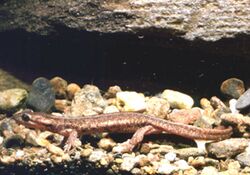Biology:Euproctus
From HandWiki
Short description: Genus of amphibians
| Euproctus | |
|---|---|

| |
| Euproctus montanus | |
| Scientific classification | |
| Domain: | Eukaryota |
| Kingdom: | Animalia |
| Phylum: | Chordata |
| Class: | Amphibia |
| Order: | Urodela |
| Family: | Salamandridae |
| Subfamily: | Pleurodelinae |
| Genus: | Euproctus Gené, 1838 |
| Type species | |
| Euproctus rusconii Gené, 1838
| |
| Diversity | |
| 2 species (see text) | |
Euproctus, the European mountain salamanders, is a genus of salamanders in the family Salamandridae from Sardinia and Corsica.[1]
Species
| Image | Scientific name | Common Name | Distribution |
|---|---|---|---|
 |
Euproctus montanus (Savi, 1838) | Corsican brook salamander | Corsica |
 |
Euproctus platycephalus (Gravenhorst, 1829) | Sardinian brook salamander | Sardinia, Italy |
The Pyrenean brook salamander used to be included in this genus as Euproctus asper, but was moved to Calotriton in 2005.[3][4] Its superficial similarity with Euproctus likely represents convergent evolution: strongly depressed head and body, and reduction or even absence of lungs, are adaptations to fast-running, well-oxygenated mountain streams.[4]
References
- ↑ 1.0 1.1 Frost, Darrel R. (2014). "Euproctus Gené, 1838". Amphibian Species of the World: an Online Reference. Version 6.0. American Museum of Natural History. http://research.amnh.org/vz/herpetology/amphibia/Amphibia/Caudata/Salamandridae/Pleurodelinae/Euproctus.
- ↑ "Salamandridae". AmphibiaWeb: Information on amphibian biology and conservation. [web application]. Berkeley, California: AmphibiaWeb. 2015. http://www.amphibiaweb.org/lists/Salamandridae.shtml.
- ↑ Frost, Darrel R. (2014). "Calotriton Gray, 1858". Amphibian Species of the World: an Online Reference. Version 6.0. American Museum of Natural History. http://research.amnh.org/vz/herpetology/amphibia/Amphibia/Caudata/Salamandridae/Pleurodelinae/Calotriton.
- ↑ 4.0 4.1 Carranza, S.; Amat, F. (2005). "Taxonomy, biogeography and evolution of Euproctus (Amphibia: Salamandridae), with the resurrection of the genus Calotriton and the description of a new endemic species from the Iberian Peninsula". Zoological Journal of the Linnean Society 145 (4): 555–582. doi:10.1111/j.1096-3642.2005.00197.x.
External links
Wikidata ☰ Q1377354 entry
 |

